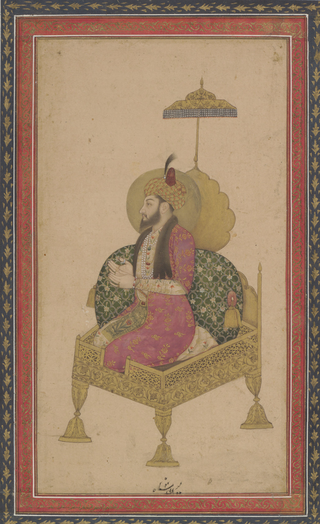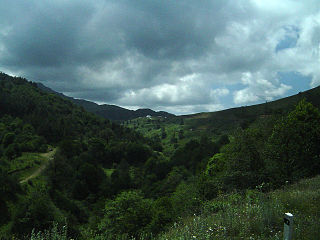
The Qara Qoyunlu or Kara Koyunlu, also known as the Black Sheep Turkomans, were a culturally Persianate, Muslim Turkoman monarchy that ruled over the territory comprising present-day Azerbaijan, Armenia, northwestern Iran, eastern Turkey, and northeastern Iraq from about 1374 to 1468.
This is a timeline of major events in the Muslim world from 1400 AD to 1499 AD.

Shah Rukh or Shahrukh Mirza was the ruler of the Timurid Empire between 1405 and 1447.

Muzaffar al-Din Jahan Shah ibn Yusuf was the leader of the Qara Qoyunlu Oghuz Turkic tribal confederacy in Azerbaijan and Arran who reigned c. 1438 – 1467. During his reign he managed to expand the Qara Qoyunlu's territory to its largest extent, including Eastern Anatolia, most of present-day Iraq, central Iran, and even eventually Kerman. He also conquered neighbouring states. He was one of the greatest rulers of the Qara Qoyunlu. He was also allegedly fond of drinking and entertainment. During his reign Jahan Shah had the Gökmedrese and Muzafferiye theological schools constructed in his capital city Tabriz.
The Battle of Chalagan was fought between the Qara Qoyunlu and the allied forces of Kingdom of Georgia, the Princedom of Simsim and Shirvanshah at Chalagan, Azerbaijan, in December 1412, and resulted in Qara Qoyunlu’s victory.

Mirza Jalal-ud-din Miran Shah Beg, commonly known as Miran Shah, was a son of the Central Asian conqueror Timur, founder of the Timurid Empire.

The Jalayirid Sultanate was a Mongol Jalayir dynasty which ruled over modern-day Iraq and western Iran after the breakup of the Mongol khanate of Persia in the 1330s. It lasted about fifty years, until disrupted by Timur's conquests and the revolts of the Qara Qoyunlu Turkoman. After Timur's death in 1405, there was a brief attempt to re-establish the sultanate in southern Iraq and Khuzistan. The Jalayirids were finally eliminated by the Qara Qoyunlu in 1432.

Khalilullah I, also known as Sultan-Khalil (سلطان-خلیل), was the Shirvanshah from 1418 to 1465. He was the son and successor of Ibrahim I. He was succeeded by his son Farrukh Yasar.
Sultan Ahmad was the ruler of the Jalayirid Sultanate, he was son to the most accomplished ruler of the sultanate, Shaykh Uways Jalayir. Early in his reign, he was involved in conflicts with his brothers. He would later suffer from several defeats with Timur and eventually imprisoned by the Mamluks. After being set free, he attacked his old enemy, the Qara Qoyunlu but was later captured and executed 1410.

The Aq Qoyunlu or the White Sheep Turkomans was a culturally Persianate, Sunni Turkoman tribal confederation. Founded in the Diyarbakir region by Qara Yuluk Uthman Beg, they ruled parts of present-day eastern Turkey from 1378 to 1503, and in their last decades also ruled Armenia, Azerbaijan, much of Iran, Iraq, and Oman where the ruler of Hormuz recognised Aq Qoyunlu suzerainty. The Aq Qoyunlu empire reached its zenith under Uzun Hasan.

Abu NasrQara Yusuf ibn MohammadBarani was the ruler of the Qara Qoyunlu dynasty from c.1388 to 1420, although his reign was interrupted by Tamerlane's invasion (1400–1405). He was the son of Qara Mahammad Töremish, a brother-in-law to Ahmad Jalayir.

Qara Iskandar ruled the Qara Qoyunlu or Black Sheep Turcoman tribe from 1420 to 1436. His struggles with the Timurid ruler Shah Rukh show that he was a brave leader, but he was not able to continue developing what he inherited from his father Qara Yusuf; his reign also saw the decline of the Qara Qoyunlu.

The Battle of Qarabagh was fought on February 4, 1469, between Aq Qoyunlu under Uzun Hasan, and the Timurids of Samarkand under Abu Sa'id Mirza, resulting in the latter's defeat, imprisonment and execution. After the battle, the Timurids forever lost any hopes of gaining Iraq or Iran back into their kingdom.

The Battle of Chapakchur was a decisive battle fought between Qara Qoyunlu under the leadership of Jahan Shah and Aq Qoyunlu under the leadership of Uzun Hasan. Jahan Shah was defeated by Uzun Hasan in a battle near the sanjak of Çapakçur in present-day eastern Turkey on October 30, 1467.
The Battle of Algami Canal was fought between Kara Koyunlu under their Bey, Qara Yusuf and the Timurid Empire under the leadership of Timur's grandson Abu Bakr bin Miran Shah for control of Baghdad and therefore Iraq in late 1402.
Amir Isfahan is the second son of Qara Yusuf after Pirbudag, brother of Qara Iskander. He was the judge of Baghdad in 1433-1445.
Bayram Khwaja was the founder of the Qara Qoyunlu, a Muslim Turkoman tribal confederation, that in a short space of time came to rule the territory comprising present-day Azerbaijan, Georgia, Armenia, northwestern Iran, eastern Turkey, and northeastern Iraq from about 1374 to 1468.
Rustam Mirza was a Timurid prince and a grandson of the Central Asian conqueror Timur by his eldest son Umar Shaikh Mirza I.
Fakhr al-Din Qutlugh-bey was the second Aq Qoyunlu bey, ruling from 1362-1389. His full name was Haji Fakhr al-Din Kutlug ibn Tur Ali-bey.
The High Middle Ages, or Classic Feudalism Period in what constitutes the present-day Republic of Azerbaijan, lasted from around the 11th century to the 15th century AD. The High Middle Ages were preceded by the Early Middle Ages and were followed by the Late Middle Ages, which ended around the 15thcentury AD. Key historical trends of the High Middle Ages include the incorporation of the territories that constitute present-day Azerbaijan into the Seljuk Empire, the establishment of the Eldiguzids, the Mongol invasions and the rule of the Ilkhanate, the invasions of Timur and the establishment of the Turkoman Kara Koyunlu and Aq Qoyunlu tribal confederations.











